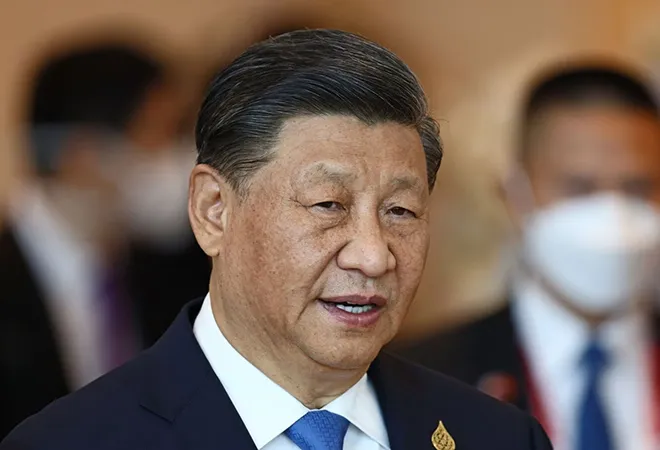In recent years, China has been navigating a labyrinth of socio-economic challenges under the leadership of Xi Jinping. From the bustling streets of Beijing, a vivid picture of a nation grappling with a myriad of issues that are shaping public sentiment and policy, emerges. China’s once-booming economy has hit a significant slowdown. The days of double-digit GDP growth are a distant memory, replaced by more modest figures that reflect deeper structural issues. The economic deceleration is compounded by rampant corruption, which continues to plague various sectors despite Xi’s high-profile anti-corruption campaigns.
These efforts, while notable, have not eradicated the deeply entrenched practices that undermine public trust and economic efficiency. The wealth gap in China is widening at an alarming rate. The richest 10% of the population now control a significant portion of the country’s wealth, while the bottom 50% struggle to make ends meet. This disparity is starkly visible in urban centres like Beijing, where luxury high-rises stand in stark contrast to dilapidated housing. Youth unemployment is another pressing issue, with rates reaching unprecedented levels. The mismatch between educational outcomes and job market demands leaves many young graduates disillusioned and frustrated.China’s housing crisis is a ticking time bomb. The real estate sector, once a pillar of economic growth, is now a source of instability. Unfinished construction projects and plummeting property values have led to widespread mortgage boycotts and financial distress among homeowners. The government’s attempts to stabilize the market have so far been insufficient, leaving many citizens in a precarious situation. Under Xi’s leadership, government control has tightened across all aspects of life. The Chinese Communist Party (CCP) has consolidated its power, ensuring that dissent is swiftly silenced. This centralization of authority has stifled political pluralism and curtailed freedoms, creating an environment where public criticism is risky.
Despite these challenges, China remains politically stable. The CCP’s grip on power is unchallenged, and there are no significant movements threatening Xi’s leadership. This stability, however, comes at the cost of personal freedoms and open political discourse. The government’s extensive propaganda efforts have also fostered a strong sense of anti-Americanism, further entrenching biases against Western values. The issue of Taiwan remains a contentious topic. Many in China view the reunification of Taiwan as a non-negotiable goal, with some believing that force is the only viable option. This sentiment is fuelled by nationalistic propaganda and a historical narrative that frames Taiwan as an inseparable part of China. Xi Jinping’s China is a complex and multifaceted reality. While the country faces significant socio-economic challenges, the CCP’s control remains firm. The future of China will depend on how these issues are addressed and whether the government can balance economic growth with social stability and political freedoms. The path forward is fraught with difficulties, but also with the potential for profound change.
CHINA’S EXPORT CONTROLS
In an era where technology is the backbone of economic and strategic power, China’s export controls are reshaping global supply chains, with profound implications. Beijing’s meticulous sharpening and testing of its tools for controlling technology-related outflows aim to keep supply and value chains within China, making the country indispensable in global technology production. China’s approach to export controls is multifaceted and strategic. The party state employs dual-use export controls flexibly, presenting itself as a responsible stakeholder contributing to non-proliferation while simultaneously supporting domestic industries. This dual-use strategy allows China to signal its ability to mobilize controls for other ends, such as retaliation, if necessary. Uniquely, China has developed a parallel civilian technology export control regime focused on protecting domestic innovation and industrial capacity. This regime is increasingly deployed to establish and defend China’s dominance in supply chains.
Xi Jinping’s push for “comprehensive national security” has further expanded the toolkit, repurposing various instruments to manage technology outflows. China’s ability to monitor and limit cross-border flows of capital, data, talent, and intellectual property is unmatched by any other economy.
In August 2023, China began requiring licences for the export of gallium and germanium metals and their compounds. This move was widely seen as a response to coordinated restrictions on semiconductor technology exports from the United States, Japan, and the Netherlands. By controlling these critical materials, China aims to maintain its leverage in the semiconductor supply chain, which is vital for numerous high-tech industries. In December 2023, China tightened export controls on certain graphite products and banned the export of technology used to make rare earth magnets. These materials are crucial for various advanced technologies, including electric vehicles and renewable energy systems.
By restricting access, China reinforces its position as a key supplier and can exert significant influence over global technology markets. China’s civilian technology export control regime is designed to protect domestic innovation and industrial capacity. This regime has been increasingly used to establish and defend China’s supply chain dominance. For instance, the regime’s application in the semiconductor industry has helped Chinese firms climb up the value chain, making them critical players in global technology production. Governments and firms must prepare for an era where China is more willing and able to exploit its advantages along technology value chains. The strategic use of export controls by China poses several challenges:
Global reliance on Chinese materials and technologies means that any restrictions can lead to significant disruptions. Diversifying supply sources and investing in domestic capabilities are essential steps to mitigate these risks. As China continues to climb the technology value chain, firms may find themselves increasingly dependent on Chinese innovations.
This dependence could limit global strategic autonomy and bargaining power in global markets. China’s ability to use export controls as a tool for retaliation adds a layer of complexity to international relations. Policymakers must navigate these tensions carefully, balancing economic interests with strategic considerations. In conclusion, China’s export controls are a powerful tool in its quest for technological dominance.
Dalai Lama’s nephew, Khedroob Thondup is a geopolitical analyst.

